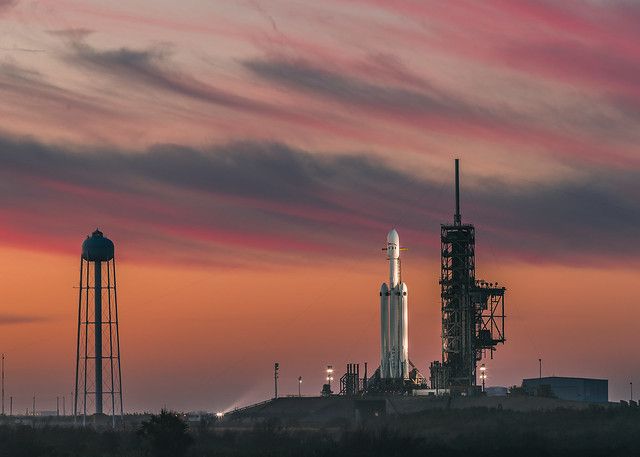
CAPE CANAVERAL, Fla. — SpaceX's megarocket, the Falcon Heavy, is poised for flight. Perched atop NASA's historic Pad 39A, the behemoth will lift off sometime during a 4-hour window that opens tonight (June 24) at 11:30 p.m. EDT (0330 GMT June 25).
After liftoff, the huge rocket's two side boosters and central core stage are expected to return to Earth for a triple landing. You can watch all the action right here and on Space.com's homepage, courtesy of NASA, beginning about 30 minutes before liftoff. You can also watch the launch directly from SpaceX's webcast page.
The upcoming mission, known as STP-2, is managed by the Air Force via its Space Test Program (STP for short), and is the next epic ride-share endeavor SpaceX plans to pull off. SpaceX has packed 24 satellites inside the rocket's nose cone, marking the first time the massive rocket will carry more than one satellite. In contrast, its counterpart, the Falcon 9 is a top-rated cosmic Uber driver, having ferried more than 60 satellites into orbit in a single launch.
Related: This Is What 2 Dozen Satellites Look Like Packed for Launch on a SpaceX Falcon Heavy
Falcon Heavy achieved operational status in April when it hoisted a massive communications satellite, dubbed Arabsat-6A in to space. Following a series of delays due to poor weather conditions and pesky upper-level winds, the massive rocket's second flight went off without a hitch.
After depositing their payload, the boosters stuck their landings at Cape Canaveral Air Force Station. The central core also successfully touched down on a SpaceX droneship, but the journey back to port proved to be disastrous. The booster fell victim to rough seas, toppling over into the ocean before reaching shore.
The landing marked the first triple-rocket landing and occurred a little over a year after the Falcon Heavy's demo mission catapulted a cherry-red Tesla and a dummy nicknamed Starman into space. That landing was a partial success: the two side boosters stuck their landing, but the center core missed the drone ship and crashed into the ocean.
All three of the Heavy's first-stage boosters are designed to be reusable. In a first, the STP-2 mission will rely on preflown side boosters to make the climb to orbit. The scorched side boosters, which ferried Arabsat-6A into space, are two recent additions to SpaceX's growing fleet of flight-proven rockets.
The company dazzled the world in 2015 when it landed its first rocket. Sonic booms echoed above the space coast — a first since the shuttle era — but SpaceX didn't refly a used booster until two years later. Now, landings have become so routine that onlookers question when a shiny new Falcon launches instead of a sooty veteran.
SpaceX is hoping for fair winds and following seas for its planned booster recovery attempt. Last week, company CEO Elon Musk tweeted that this will be the company's most difficult launch attempt so far. That's because of the range of orbits the satellites need to reach.
The U.S. Air Force has already certified Falcon Heavy to fly national security payloads, but this is the vehicle's first launch carrying a government payload, so the Air Force is paying close attention to how the vehicle performs during launch.
According to the company's mission profile, the whole flight will take roughly six hours as the rocket will have to complete "four separate upper-stage engine burns, three separate deployment orbits and a final propulsive maneuver."
Among the passengers the Falcon Heavy is carrying are an atomic clock built by NASA, a satellite designed to test a greener spacecraft propellant and a solar-sailing cubesat dubbed LightSail 2 from The Planetary Society.
Tonight's launch will be the first nighttime flight for Falcon Heavy, and as an added bonus, the California-based rocket manufacturer hopes to pull off something special: catching a fairing, the pair of halfshells that surrounds payloads during launch. A boat named Mr. Steven joined the SpaceX fleet in 2017 to do just that, but so far its attempts to snag a fairing have come up short.
Essentially a mobile catcher's mitt, the ship is outfitted with a giant net attached to four outstretched arms, designed to catch fairings as they fall back to Earth. Each fairing costs around $6 million — one tenth of the Falcon's total price. Historically they have been one-time use components, but SpaceX is hoping that by netting the fairing halves before they reach the sea, they can limit the corrosive effects of sea water.
To achieve that goal, engineers have equipped each fairing half with tools to help navigate itself back to Earth, including a parachute that deploys enabling the massive piece of hardware to gently touch down in the ocean or an outstretched net.
Earlier this year, rough seas damaged the vessels arms; however, the former offshore supply vessel recently received a makeover. Perhaps now it has the proper tools to succeed.
Follow Amy Thompson on Twitter @astrogingersnap. Follow us on Twitter @Spacedotcom or Facebook.
https://www.space.com/spacex-falcon-heavy-milestone-launch-webcast.html
2019-06-24 11:00:00Z
52780319697650
Tidak ada komentar:
Posting Komentar